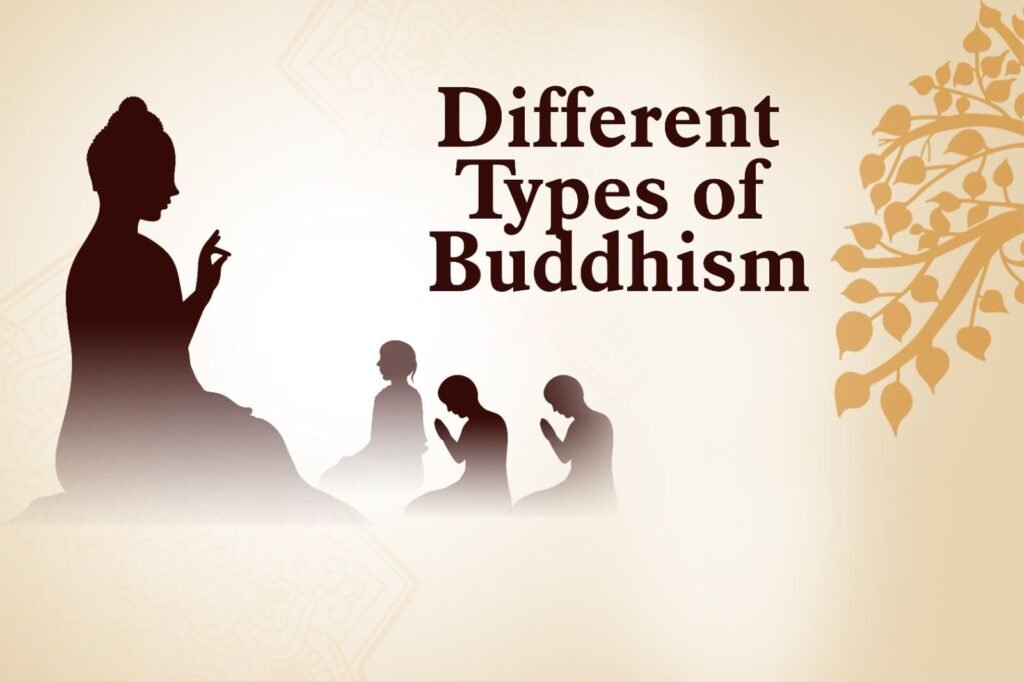Table of Contents
ToggleBuddhism is an ancient belief system viewed by someone as a religion and others as a philosophy. Siddhartha Gautama (Buddha), a wandering teacher who lived in the 6th or 5th century BCE, is the founder of Buddhism. Buddhism emerged in the Northeastern region of the Indian subcontinent. The teachings of Buddhism were attracted by many people, leading to the spread of Buddhism into different regions. It is stated that Buddhism encompasses different types of Buddhism, with unique practices and beliefs.
Different Types of Buddhism
Theravada Buddhism, Mahayana Buddhism, and Vajrayana Buddhism form the three school of Buddhism.
1. Theravada Buddhism
Theravada Buddhism or “the doctrine of elders” is the major form of Buddhism prevalent in Sri Lanka, Cambodia, and Myanmar etc. It draws its spiritual inspiration from Pali canon or Tipitaka and commonly accepted as the core records of Buddha teachings. Theravada Buddhism consist of two fundamental concepts are “Nirvana” and “Arhat.” The ideal goal of Theravada Buddhism is to obtain nirvana at the end of their way of life. Individuals who live in Nirvana are called “Arhat.” Arhat means “the perfect being.”
Theravada Buddhism has its origin in India around 500 BC. It is widely practiced in South Asian countries. The instant goal of Theraveada Buddhism is to attain a better rebirth. This is achieved through religious rituals like the ritual caroling of religious texts called “paritta.” People who want to become an Arhat should follow four steps. It encompasses “Sotapanna”, “Sakadagamin”, “Anagami”, and “Arhat.”
2. Mahayana Buddhism
Mahayana Buddhism is another major stream of Buddhism. The Sanskrit word Mahayana means “excellent vehicle.” Mahayana Buddhism specifies the route of Bodhisattva attaining enlightenment. It is said that the origin of Mahayana Buddhism is not specifically found. But some scholars believed that Mahayana Buddhism arose in the 1st century CE. According to the idea of Buddhist tradition the freedom of oneself is the freedom of all beings.
Therefore the fundamental goal of Mahayana Buddhists is to become a Bodhisattva a conscious being to help others to attain enlightenment. The philosophy of Mahayana Buddhists also encourages unique theories such as theory of emptiness, the doctrines of consciousness, and the Buddha nature teachings etc.
3. Vajrayana Buddhism
Vajrayana Buddhism is the third major stream of Buddhism. It also knows “Diamond vehicle”, “Thandrayana” etc. Vajrayana is the path to attain enlightenment. And this stream of Buddhism comes from the Mahayana tradition. Vajrayana Buddhism otherwise called “Esoteric Buddhism” concentrates mysterious practices and rituals. The main features of Vajrayana Buddhism include:
– Use of Mantras or chanting’s
– Strong emphasis on Guru
– Significance of meditation incorporating concentration approaches such as visualization of Bodhisattva.
One of the peculiar features of Vajrayana Buddhism is its focus on esoteric transmission, where teachings are passed directly from the Guru or “Vajracharya” to the students through initiation of ceremonies.
Read more about – Vajrayana Buddhism
Regional Variations In Buddhism
Tibetan Buddhism
Tibetan Buddhism, otherwise known as Vajrayana or Tandric Buddhism emerged in Tibet in the 7th century and practiced in Tibet, Bhutan, and Mongol. Tibetan Buddhism incorporates practices such as mantras, yoga, and mediations etc. and advocates the principal of four noble truths. The ideal goal of Tibetan Buddhism is to achieve the Buddhahood or Vajrayana path more quickly. It focuses on the intellectual discipline of Madhyamika and the philosophy of Yogacharya. Tibetan Buddhism encompasses both tantric practices and Mahayana Buddhism. Nyingma, Kagyu, Sakya, and Gelug form the major school of Tibetan Buddhism.
Zen Buddhism (Japan)
Zen Buddhism or Chan Buddhism was developed in china and later spread to Vietnam, Korea, and later came into East Japan. Zen Buddhism emphasizes “one’s true nature” or Buddha nature. It focuses on direct experience and insights. Meditation is one of the core of Zen Buddhism aims to cultivate mindfulness and one’s true nature. Zen Buddhism motivates the Practitioners to focus on the thoughts, feelings, and actions in the present moment and become aware of that. It prioritizes simplicity and non- duality.
Pure Land Buddhism (China and Japan)
Pure Land Buddhism, otherwise called Pure Land School is a stream of Mahayana Buddhism. It emphasizes achieving the re-birth in a pure Land. This form of Buddhist tradition is mostly practiced in East Asia. The other name of pure land Buddhism is “Lotus school.” The practices and concepts of pure land Buddhism are a significant component of the traditions of Mahayana Buddhism in China, Japan, Korea and Vietnam etc.
One of the peculiar features of East Asian Pure Land Buddhism is that ordinary people may attain non- retrogression and finally obtain the Buddhahood without their karma whether it is good or bad.
Nichiren Buddhism (Japan)
Nichiren a Japanese Buddhist priest developed Nichiren Buddhism in the 13th century based on the teachings of Nichiren. It is a form of Mahayana Buddhism an considered as the largest school of Japanese Buddhism. According to Nichiren “Lotus sutra” (Buddhist Scripture) contains the ideal truth of the teachings of Buddha and it forms the core of Nichiren Buddhism.
In Lotus sutra, all beings are possible to achieve Buddhahood and can attain enlightenment. Nichiren believed that his practices were necessary for achieving “nirvana” and developing the political and social conditions of Japan. Faith, practice, and learning are the three main pillars of Nichiren Buddhism.
Thai Forest Tradition (Thailand)
Thai Forest Tradition is major branch of Theravada Buddhism in Thailand. “Ajahn Mun Bhuridatto” a Thai Buddhist monk is the founder of Thai Forest Tradition in 1900. It upholds the strict monastic rules laid by Buddha. Thai Forest Tradition is otherwise referred to as “Kammatthana Forest Tradition of Thailand.” It prioritises the meditative practices and realization of enlightenment. It is believed that the purpose of these practices is to achieve deathless. They placed high value on monastic life and said that monasteries follow the path of Buddha contemplative insights helps to attain the inner truth and peace.
Influence and Spread of Buddhism
Buddhism in Southeast Asia
Buddhism played a key role in spreading its idea to various parts of the world and people. Its influence had seen in commercial and political structures. Through trade routes, Buddhism spread to Southeast Asia and become a mostly followed religion in many countries. Buddhist architecture and arts such temples, stupas, and scriptures form the eminent features of Southeast Asia. Buddhist teachings, literary traditions, and rituals all contributed to the rich cultural heritage of the region and shaped the political thought of people.
Buddhism in East Asia
Buddhism is spread in East Asia through the networks of trade in Silk Road and missionary works. East Asia is greatly influenced by Nichiren Buddhism, Pure Land Buddhism, and Esoteric Buddhism of China. Particularly influenced its culture in China, Japan etc. Trading activities paved way for the spread of Buddhism from India to East Asia.
Buddhism is adapted by chines people, leading to the development of Buddhist schools. The practices and beliefs of Buddhism influenced the everyday life of people. Buddhist influence can be seen in Art, architecture, philosophy, and literature of China.
Buddhism in West
Western people were greatly influenced by the practices and teachings of Buddhism. Professional scholars played a vital role in spreading Buddhism to West. Moreover, the artistic and cultural works leading to the influence the people towards Buddhism. Asian immigration is one of the prime factor leading to the spread of Buddhism. Writers, philosophers, and artists and their works contributed to the spread of Buddhism to the West.
Conclusion
In short from the above aspects, it is said that Buddhism reached a vast area of the world and had great influence on the life of people particularly in the cultural and social aspects. Emphasizing the teachings and practices, Buddhism forms one of the great religion as well as philosophy of the world.Hope this blog gives an enormous idea about both these sects of Buddhism. For more such Buddhism-related topics visit our website Hiddenmantra.








